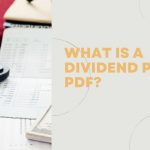What is a Dividend Policy PDF?

A dividend policy is a plan that determines the percentage of earnings to distribute to shareholders. A company’s dividend policy can be considered an agreement between the company and its shareholders that defines how much of the company’s profits will be distributed over time. Particular factors — like expected earnings growth — may affect this decision. Still, generally speaking, companies should strive for distributions that maintain a stable payout ratio over time and provide some income level for investors.
Benefits Of A Dividend Policy PDF
1. A stable payout ratio
A stable payout ratio means that the company distributes an income equal to its earnings. It helps keep shareholders happy, as they won’t lose their investments to the effects of changes in management or the economy when they sell their shares.
2. Maximized return on investment
Corporations value that investors will only sell when they see a decrease in their profit or a decline in dividends. Keeping a stable payout ratio means maximizing your return on investment and ensuring you are paying your shareholders accordingly.

3. Accurate financial metrics
Having a stable payout ratio can give you a better idea of how well the dividend formula works and allows for more accurate financial metrics about the company. Objective metrics can help shareholders better evaluate a corporation’s performance and prospects.
4. Dividend growth
Research strongly suggests that dividend policies that grow dividends over time lead to more robust stock price increases than those that do not. It is because it builds confidence in the company and its management, creating a positive feedback loop that drives up stock prices. By maximizing the return on investment, stable dividend distributions also increase your chances of generating a rising average share price, which leads to higher total returns for all shareholders.
5. Improved balance sheet
When a corporation’s payout ratio is equal to or greater than 100%, its financial health is in danger. On the other hand, stable and growing distributions create shareholder value and improve a company’s balance sheet by increasing shareholder equity. These factors, which are primarily influenced by the dividend policy, help ensure that a company continues to be able to pay shareholders without depleting its resources.
6. Increased stability
Beyond the fact that stable distributions are suitable for financial health and balance sheets, they also help ensure that a company can provide dividends in the future. If payments decrease significantly, maintaining the same profitability and credibility cannot be easy. Research has found that companies with predictable profit distributions show more excellent stability and fewer headwinds than those with less stable dividend policies.

7. Increased capital allocation
Allocating more capital to shareholders directly correlates with better financial health, as I’ve found in my research of companies’ dividend policies. It was one of my original motivations for researching this particular topic!
8. Maximized return on capital
Corporations can distribute more than 50% of their earnings to shareholders through dividend payments, which means that they are effectively disengaging from the business. I’ve found in my research that corporate distributions should not exceed a company’s retained earnings — the amount of money that is available for reinvestment into the corporation. If a company has a high payout ratio and consumes too much or too little of its resources, this could lead to trouble down the road.
9. Long-term financial security
Stable and growing distributions are not only good from an investment perspective but also for long-term financial security. Although a corporation can do fine without dividends, the shareholders are often left in the dark. Therefore, investing in companies with policies that perform well helps to ensure your financial security over time.
10. Higher valuation
Research supports the theory that high-dividend stocks trade at higher valuations than their low- or no-dividend counterparts. Investors view dividends as a sign of company stability and will pay more for them. This sort of valuation premium can be beneficial when trying to determine how much value an individual stock or portfolio is worth — it just means you can afford to buy more shares while maintaining a certain level of diversification!
Final Verdict
First, it is essential to understand that different types of automated dividend reinvestment systems (DRIS) differ in their capabilities and settings.
The DRIS choice should be based on one’s risk tolerance, profitability expectations of the investment, the intended use of the DRIS funds, and desired performance metrics.
Dividend Reinvestment Plan has been a preferred method for many investors to implement and maintain a dividend income stream. To get the most out of DRIP investing, as well as limit any possible negative impacts from such investment, it is essential that investors understand their options, including a review of each available DRIS service provider.